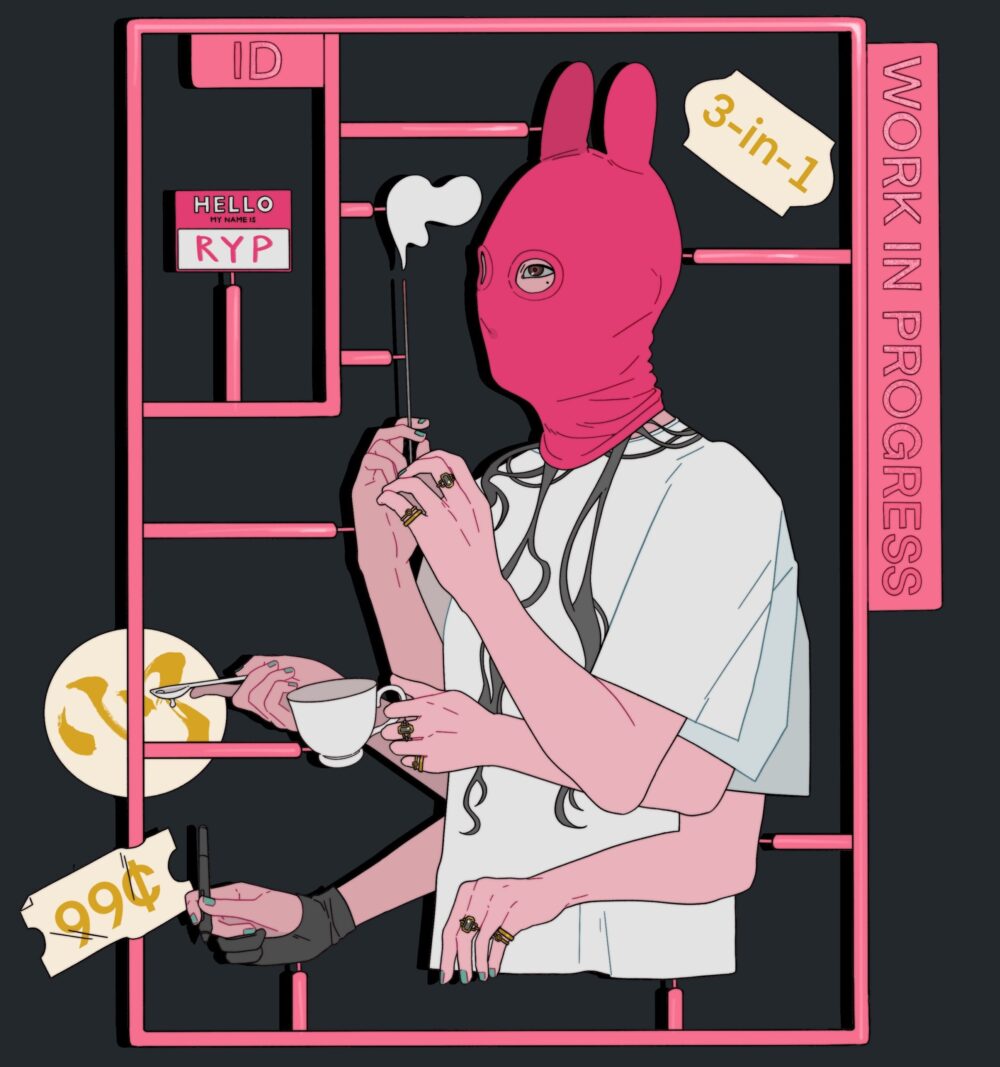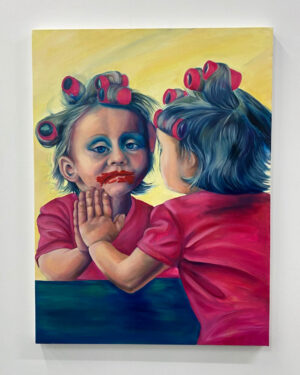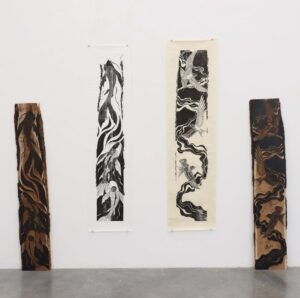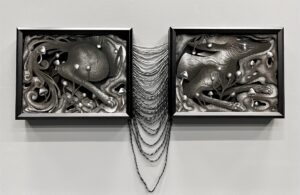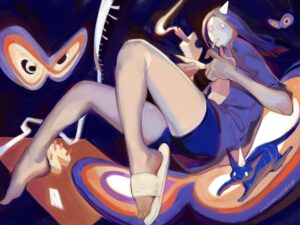心/ MYTHOS
Yejin Park

—the paradox of ‘becoming’ and ‘not becoming’ by deconstructing and reconstructing one attitude called ‘tradition,’ learning and escaping, or ‘realizing and unrealizing.’
– Tradition (Un)Realized, siren eun young jung

█ TO YOU
I have a particular sensitivity to portraying often-overlooked stories. This draws from my lived experience as an immigrant to the US and Canada, as a returnee/diaspora to my home country, and as a social minority at other times.
My art practice in general deals with looking for points of tension and takes cues from history and tradition. Matters of tradition have always been a fraught area to many like me who are split between cultural upbringings. My interest in history and visual genealogy lends itself to crafting illustrations that explore these intersectional identities.
In my understanding; tradition, history, and myths are framed as a lens to look for something new—rather than understanding any of these three as restrictive. The projects below were created considering these three topics not as a limiting factor, but as a medium in which their emancipatory potential can be freely explored.
Art and research can be employed as a way of looking for alternative histories and narratives in areas that insist have none. Gaps, erasures, and contradictions can aid in painting a rich portrait of not just one subject, but allows us to imagine what else may have been lost in those bastard translations.
OF MYTH, TRADITION, AND HISTORY.
The SHIM 心 HWATU DECK is a reimagining of the hwatu deck; originally brought to the Korean peninsula in the 19th century as hanafuda cards.
█ SHIM 心 HWATU DECK
↳ INTRODUCTION
↳ CONCEPT
↳ PRESENTATION
MYTHOS is an ongoing series of illustrations that act as a visual exploration of the intersections between tradition and myth.
█ MYTHOS: SELECTED WORKS
↳ INTRODUCTION
↳ GALLERY

SHIM 心 HWATU DECK
█ INTRODUCTION
The SHIM Hwatu Deck is a project of mine I’m excited to share with you. I grew up shuffling these cards and learning to play from a much older generation. The goal of this reimagined deck is not to restore the original context of the hanafuda illustrations, but rather to try and capture the censored cards in respect to their historic context on the Korean peninsula.
Hanafuda cards are thought to have been brought to Korea sometime in the late 19th century. The drawings (that later would become the modern standard) were localized and censored in the 1950s due to changing public reception of the “Japanese aestheHwatu cards were adapted from Japanese Hanafuda cards, which are thought to have been introduced to the Korean peninsula sometime in the late Joseon period. The drawings (that later would become the modern standard) were localized and censored in the 1950s due to changing public reception of the “strong Japanese aesthetics” in the original card paintings.
I intended for this project to be a visual exploration of the history and lineage of objects such as these, but also as another personal exploration into considering tradition as a subversive medium rather than one that is restrictive.
I hope these cards capture your imagination as much as the games of old did mine.
█ CONCEPT

There are 48 cards, 12 suits – 4 cards per suit – each with a unique illustration.
Each variation (hwatu or hanafuda) comes with their own regional rules and games. A game called go-stop is the most commonly associated with hwatu cards.
The suits with the “bright” symbol within the red circles are featured first as an example of what the rest of the deck’s illustrations will follow as a theme.

The “Ribbon”, “Animal”, and “Junk” card suits are displayed alongside the “Bright” cards.





█ PRESENTATION




MYTHOS: SELECTED WORKS
█ INTRODUCTION
My personal work is influenced by relationships. Specifically, the interplay of culture and identity; as well as examining displacement in these intersections. I want to build on this “in-between-ness” with help from a visual library that pulls from more traditional East Asian artwork, techniques, history, and my own violently active memory.
Over a period of time, my mediums of choice have fueled my interest in uncovering more subversive accounts in history. Traditional techniques, such as Korean folk painting and literati works, have been subjected to historic bias shaped by modernization. Where and how these mediums are used contribute to how its cultural contemporaries are perceived and constructed. With this in mind, similar techniques are employed as a means for my own method of discovery.
The constant compulsion to interrogate visual histories and language is (in a wonderful way perhaps, selfishly) related to my own interests in microhistories, collecting esoteric knowledge, and tracing the visual genealogy of the things we look at and assign meaning to.
I would love to make the viewer linger a little longer on an image—to take a second glance at what’s in front of them. Asking this “examination” of someone else; while allowing the viewer to feel part of a larger disobedient audience for having asked:
What am I looking at?
These are the places wherein we are invited to confront our ideas of value, of constructing “the story”, and the function of revising memory in these relationships. Revealing alternative narratives—in this two-way exchange—is what makes for a fuller visual language by the end.


CLEAR SPRING —
An entanglement of body and nature. A head pokes out among spring lettuce (bomdong/봄동). This clear, tentative spring always comes after violent rain.
SILK —
Monsoon season pushes vegetation to the ground, where the creatures below enjoy the late harvest they’ve waited patiently for.


TIGER (THE HUNTER) —
Tigers, both real and imagined, are a symbol of both the Korean peninsula’s physical and cultural landscapes.
In their presence; a trickster, divine messenger, and protector.
In their absence; a sign of the changing landscape—of growing populations, of industrial expansion.
An old proverb says:
“Korean people hunt tigers half of the year, and tigers hunt people the other half of the year.”
MERIDIAN — Inspired by Donna Haraway’s cyborg. Acupuncture and meridian lines are imagined as circuitry that runs through the body.


THE FOX SISTER —
The title for this piece is taken from the folk story it was inspired by, The Fox Sister/여우누이.
There are many tales in which you may observe the symbolic Gumiho, or fox spirit. Similarly, there are many variations to how such a creature retains or earns its humanity.
In some, a Gumiho is supposed to eat the livers of 1,000 men within 1,000 years to become human. Others say that a Gumiho can become a human being if it can last 1,000 years without eating or killing anything.
However different the details may be, one thing is certain—for all her cunning, beauty, and desire to live, the creature’s earnest wish and the ultimate goal is to become human.
THE BIRD MAIDEN —
The bird-maiden appears in stories of varying cultural origins. Despite the differences in context, we are often shown a girl who, far from home, has been trapped into a union through the strength and guile of a stranger. There is a demand for the girl to be both bird (for this is what makes her otherwordly), and woman (which positions her as a potential wife). Migratory and trapped. That is her nature and fate —to be both and neither.
Cranes are often employed as a motif of a symbolic link between heaven and earth, so perhaps the stories can not just be interpreted as a literal taking of the bird-maiden as a wife—but of a mortal man’s meddling with matters of life and death.


BANTAM —
The rooster keeps time for the sun and draws a line in the ground; a sharp toenail proves its will to fight. It calls and wards against malevolence.
UNDER —
The red dot of pigment on each cheek is called “yeonji”. “Gonji” is the red dot placed on the forehead. This is a kind of styling for the bride in traditional Korean weddings.


Take care.
